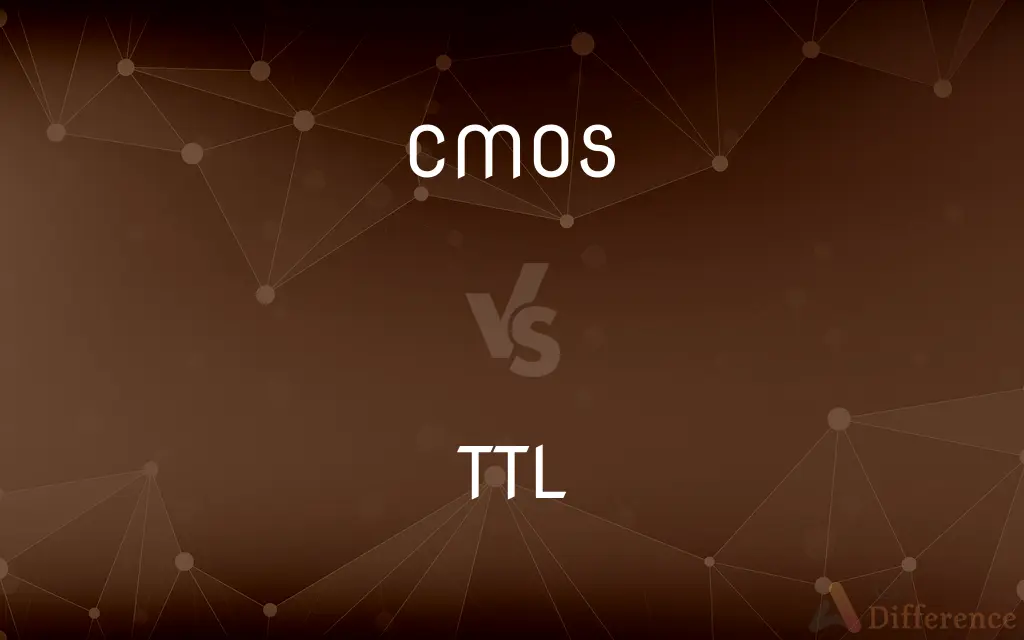CMOS vs. TTL — What's the Difference?
By Tayyaba Rehman — Published on January 26, 2024
CMOS (Complementary Metal-Oxide-Semiconductor) is a type of semiconductor technology known for low power consumption, whereas TTL (Transistor-Transistor Logic) is a class of digital circuits built from bipolar junction transistors, consume high power.

Difference Between CMOS and TTL
Table of Contents
ADVERTISEMENT
Key Differences
CMOS technology uses a combination of p-type and n-type MOSFETs, leading to low power dissipation during static operation. TTL, on the other hand, uses bipolar junction transistors, which draw more power, particularly in the idle state.
CMOS circuits are known for their high noise immunity and low static power consumption. TTL circuits, while faster in switching, have lower noise immunity and consume more power.
In terms of manufacturing, CMOS can be more complex due to the dual-type MOSFETs but offers benefits in power efficiency and scaling. TTL technology is simpler in design but faces limitations in scaling down with increased power consumption.
CMOS is widely used in microprocessors, microcontrollers, and other digital logic circuits due to its power efficiency. TTL was once the standard in digital electronics but has been largely replaced by CMOS in many applications.
CMOS technology supports higher density of logic gates on a chip, which is crucial for modern integrated circuits. TTL, with its simpler architecture, is less suited for high-density applications.
ADVERTISEMENT
Comparison Chart
Power Consumption
Low, especially in idle state
Higher, especially in idle state
Circuit Elements
P-type and N-type MOSFETs
Bipolar junction transistors
Noise Immunity
High
Lower
Usage
Microprocessors, microcontrollers
Once standard in digital electronics
Density
Suitable for high-density logic gates
Less suited for high-density integration
Compare with Definitions
CMOS
Capable of higher integration density.
CMOS technology allows more transistors to be placed on a single chip.
TTL
A type of digital logic circuit.
Older computers often used TTL logic in their design.
CMOS
A technology for constructing integrated circuits.
Modern computers use CMOS technology in their CPUs.
TTL
Less efficient in high-density applications.
For high-density circuitry, TTL is less efficient than CMOS technology.
CMOS
Used in digital logic circuits.
CMOS is a preferred choice for complex digital logic circuits.
TTL
Utilizes bipolar junction transistors.
The building block of TTL circuits is the bipolar junction transistor.
CMOS
Known for low power consumption.
CMOS chips are ideal for battery-operated devices due to their power efficiency.
TTL
Known for faster operation at the cost of power.
TTL circuits are fast but consume more power than CMOS.
CMOS
Employs complementary MOSFETs for operation.
The use of complementary MOSFETs in CMOS reduces power loss.
TTL
Has lower noise immunity compared to CMOS.
TTL circuits are more susceptible to noise than CMOS circuits.
Common Curiosities
Where is TTL technology commonly used?
TTL was historically used in computers and digital systems but is now less common due to CMOS advancements.
What are typical applications of CMOS technology?
CMOS is commonly used in microprocessors, digital cameras, and other electronic devices.
What does TTL stand for?
TTL stands for Transistor-Transistor Logic.
Can TTL circuits operate at higher frequencies than CMOS?
Historically, TTL could operate at higher frequencies, but modern CMOS technologies have surpassed TTL in speed capabilities.
How does power consumption differ between CMOS and TTL?
CMOS consumes significantly less power, especially in idle states, compared to TTL.
What does CMOS stand for?
CMOS stands for Complementary Metal-Oxide-Semiconductor.
Why is CMOS preferred over TTL in modern electronics?
CMOS is preferred due to its lower power consumption, higher noise immunity, and suitability for high-density circuits.
Is CMOS technology more expensive than TTL?
Initially, CMOS can be more expensive to manufacture, but its efficiency and scalability make it more cost-effective in the long run.
Are TTL circuits easier to design than CMOS?
TTL circuits can be simpler to design due to their straightforward architecture.
Do CMOS and TTL have different voltage levels?
Yes, CMOS and TTL have different standard voltage levels for logic 'high' and 'low'.
Can CMOS chips handle more transistors than TTL?
Yes, CMOS technology supports a higher density of transistors on a chip.
Why does TTL have lower noise immunity than CMOS?
TTL's lower noise immunity is due to its bipolar transistor design and higher power dissipation.
What is the impact of temperature on CMOS and TTL circuits?
Both CMOS and TTL performance can be affected by temperature, but CMOS is generally more stable at varying temperatures.
Is it possible to interface CMOS with TTL circuits?
Yes, but proper voltage level matching and interface circuitry are necessary.
Are there any modern uses of TTL technology?
TTL is now mostly found in niche applications or legacy systems, as CMOS has become the dominant technology.
Share Your Discovery

Previous Comparison
Paneer vs. Chena
Next Comparison
RMS vs. PMPOAuthor Spotlight
Written by
Tayyaba RehmanTayyaba Rehman is a distinguished writer, currently serving as a primary contributor to askdifference.com. As a researcher in semantics and etymology, Tayyaba's passion for the complexity of languages and their distinctions has found a perfect home on the platform. Tayyaba delves into the intricacies of language, distinguishing between commonly confused words and phrases, thereby providing clarity for readers worldwide.
















































